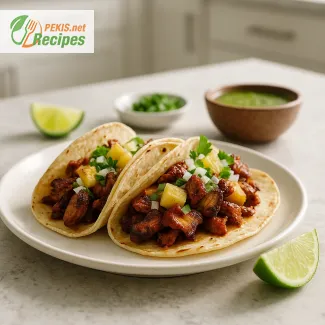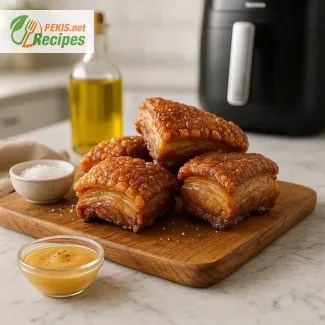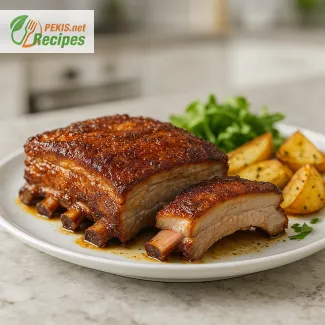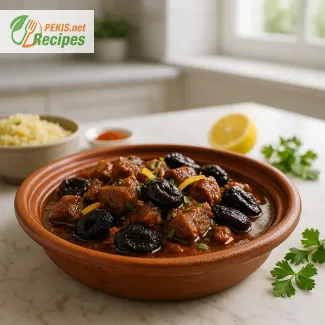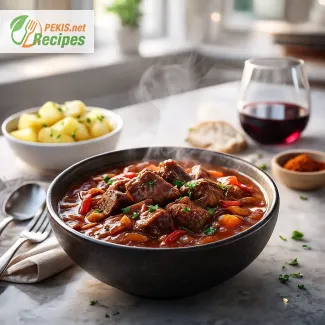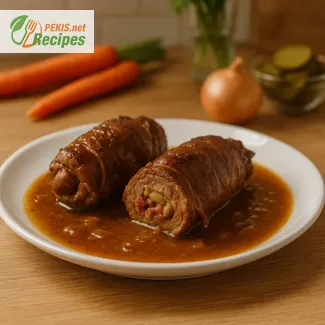
Traditional Taste of Germany in Every Bite
Discover the heartwarming story behind this classic beef roll dish
Few dishes embody the essence of German home cooking quite like Rouladen. These tender beef rolls, filled with savory ingredients and simmered in a rich gravy, have become a beloved comfort food both in Germany and beyond. With roots deeply embedded in family traditions and Sunday dinners, German Beef Rouladen tells a story not just of culinary technique, but of cultural identity and hearty, soul-warming meals.
What makes German Beef Rouladen truly special
While many meat roll recipes exist across the world, Rouladen is distinctly German due to its combination of bold flavors and methodical preparation. Thin slices of beef are layered with sharp mustard, smoky bacon, sweet onions, and tangy pickles, then carefully rolled, seared, and braised to tender perfection. The result is a meal that’s at once rustic and refined — deeply savory, slightly sweet, and unmistakably German.
Traditional Rouladen recipes are often passed down from generation to generation, and though regional variations exist, the fundamental components remain consistent. The dish’s enduring popularity lies in its satisfying depth of flavor, its versatility as a main course, and its strong ties to German culinary heritage.
Why this authentic Rouladen recipe stands out
This version of German Beef Rouladen stays true to the classic preparation, respecting every detail that gives the dish its signature taste. From using the correct cut of beef (typically top round or silverside) to the precise balance between acidic and umami elements inside the filling, this method ensures the most authentic results at home.
The preparation emphasizes slow cooking in a flavorful beef broth, often thickened into a velvety gravy that perfectly complements the stuffed rolls. The texture should be fall-apart tender, the sauce rich with the essence of seared meat and aromatic vegetables — a harmonious, deeply flavorful experience that captures the spirit of German cuisine.
Cultural significance and regional variations
In Germany, Rouladen is more than just a weeknight meal — it’s a centerpiece dish for festive occasions like Christmas or family gatherings. While the core recipe remains the same, some regions add their own flair, such as incorporating wine into the braising liquid, using speck instead of bacon, or serving the rolls with red cabbage and potato dumplings.
No matter the regional twist, the dish always symbolizes warmth, hospitality, and time-honored tradition. For those seeking an entry point into authentic German cooking, this dish offers a perfect starting place.
Pairings that elevate the experience
To enjoy Rouladen as it’s served in many German homes, consider pairing it with classic sides such as:
- Creamy mashed potatoes or Semmelknödel (bread dumplings)
- Rotkohl (braised red cabbage) for a slightly sweet contrast
- Buttered spaetzle to absorb the luscious gravy
These traditional accompaniments not only complement the flavor profile of the rolls but also create a well-rounded, satisfying meal that feels both nostalgic and indulgent.
Tips for success in your own kitchen
Making German Rouladen may seem elaborate, but each step serves a purpose — from pounding the beef thin enough to roll, to tying or skewering them securely for even cooking. Be sure to sear each roll thoroughly to lock in flavor and develop the base for a rich sauce. Low and slow braising remains the key to achieving that melt-in-your-mouth texture.
Storing and reheating Rouladen is also easy. The dish keeps well in the fridge and often tastes even better the next day as the flavors continue to develop — making it an ideal make-ahead option for gatherings or holiday dinners.
A timeless comfort food worth mastering
Whether you're reconnecting with your heritage or simply exploring traditional European flavors, German Beef Rouladen offers a deeply comforting and flavor-rich experience. It’s a dish that calls for care and patience, but rewards you with every bite. Once you've made it at home, it's bound to become a staple — not just a recipe, but a ritual of comfort, connection, and culinary excellence.
1. Prepare the filling:
Finely chop the yellow onions, slice the pickles into strips, and chop the bacon. Mix together lightly and set aside.
2. Flatten and season the beef:
Place beef slices between two sheets of parchment paper and pound until about ¼ inch (0.6 cm) thick. Season both sides with salt and pepper.
3. Fill and roll the beef:
Spread a thin layer of mustard on each beef slice. Add a small amount of onion-bacon-pickle mixture in the center. Roll the meat tightly and secure with twine or toothpicks.
4. Sear the rouladen:
Heat oil in a large Dutch oven or deep skillet. Sear each beef roll on all sides until browned. Remove and set aside.
5. Prepare the base for the sauce:
In the same pot, add chopped carrots, celery, and remaining onions. Sauté for 5 minutes. Add tomato paste and cook for another 2 minutes. Deglaze with red wine (if using), scraping the bottom of the pot. Let it reduce slightly.
6. Braise the rouladen:
Return the beef rolls to the pot. Add beef broth and bay leaves. Bring to a simmer, cover, and cook on low heat for about 90 minutes until the meat is tender.
7. Finish the sauce:
Remove rouladen and keep warm. Strain the liquid and discard solids. Return the liquid to the pot and bring to a light boil. Mix cornstarch and water in a small bowl and whisk into the sauce to thicken. Simmer for 3–5 minutes.
8. Serve:
Remove twine or toothpicks from rouladen. Serve hot with sauce drizzled over the top.
Suggested sides: Mashed potatoes, red cabbage, or bread dumplings.
Enhance the Classic: Modern Tips for Better German Rouladen
Small changes that elevate a traditional favorite
Traditional German Beef Rouladen is already a dish full of comfort, richness, and heritage. Yet with a few thoughtful tweaks, it can be adapted to suit modern preferences — whether you’re aiming for a healthier version, deeper flavor complexity, or simply more reliable results in the kitchen. By understanding the dish's components and how they interact, you can tailor your preparation to enhance its taste, texture, and nutritional profile.
Ingredient swaps that boost flavor and texture
One of the easiest ways to improve the final dish is to upgrade the quality of your ingredients. Opting for grass-fed beef results in cleaner flavor and a more tender texture when slow-cooked. If the traditional cut (top round or silverside) seems too tough, using flank steak or even thin-cut sirloin can yield softer results with less cooking time.
For the filling, the classic combination of bacon, mustard, pickles, and onions delivers bold contrasts. However, introducing caramelized shallots instead of plain onions can add sweetness and depth. Swapping standard pickles for fermented sour pickles or cornichons gives the dish more acidity and cuts through the richness of the meat.
Adding a layer of fresh herbs such as parsley, thyme, or even grated horseradish root inside the roll gives it an aromatic lift without overpowering the traditional flavors.
Tips for deepening the sauce
The gravy is the heart of the rouladen experience. To elevate its flavor, consider roasting the vegetables before deglazing the pot. This caramelization creates richer undertones. Deglazing with a splash of balsamic vinegar or Worcestershire sauce can enhance the umami and give the gravy more complexity.
For those who prefer a thicker, glossier sauce, incorporating a knob of butter at the end of cooking (also known as monter au beurre) adds silkiness and a professional finish. Reducing the braising liquid a bit longer before adding a thickener concentrates the flavor naturally without extra salt.
Homemade over store-bought: The unmatched difference
Preparing Rouladen from scratch at home allows full control over quality and seasoning. Unlike restaurant versions, which often rely on shortcuts like powdered sauces or canned stock, homemade rouladen uses real vegetables, fresh meat, and slow cooking — all of which contribute to better flavor and texture.
More importantly, cooking at home enables customization. You can adjust salt levels, choose organic ingredients, or even prepare a gluten-free or dairy-free version by simply modifying the thickeners or sides.
Common mistakes and how to avoid them
Even experienced cooks can encounter pitfalls with this seemingly straightforward recipe. Here are a few of the most frequent issues:
- Overstuffing the rouladen: Adding too much filling makes it difficult to roll and sear, causing the roll to fall apart during cooking. Use a moderate amount and roll tightly.
- Skipping the sear: Browning the rolls before braising is essential for flavor development. Don’t rush this step — a golden crust builds a foundation for the sauce.
- Thin or weak sauce: Not reducing the braising liquid enough or using insufficient aromatics (like carrots, celery, and tomato paste) can lead to a watery, flavorless sauce.
Being attentive during these steps ensures a rich, cohesive, and flavorful final dish.
Healthy alternatives without sacrificing taste
Although rouladen is traditionally indulgent, it's surprisingly easy to make it lighter. Here’s how:
- Use turkey bacon or lean pancetta instead of fatty bacon for less saturated fat.
- Replace a portion of the beef with plant-based slices such as grilled portobello mushrooms or seitan strips for a hybrid version.
- Thicken the sauce using pureed vegetables (carrots, parsnips) instead of cornstarch for added nutrients and natural texture.
- Reduce the oil used for searing by using a non-stick pan and brushing the meat lightly.
With these changes, you can create a nutrient-dense meal that still respects the structure and spirit of the original dish.
Balancing tradition with innovation
While Rouladen has its roots firmly planted in German culinary tradition, it doesn’t mean the recipe can’t evolve. With a few smart modifications — from ingredient quality to sauce technique, from health-conscious choices to more refined presentations — this beloved dish can remain a star on modern dinner tables for years to come.
The beauty of German Beef Rouladen lies in its versatility: it welcomes adaptation while never losing its warm, savory, and comforting essence. Whether you're honoring tradition or exploring new variations, the possibilities are rich, delicious, and always satisfying.
Allergens present in the recipe:
- Mustard
- Celery
Contains gluten: Only if served with wheat-based sides like bread dumplings.
Substitution tips for allergens and gluten:
- Mustard: Replace with horseradish cream or omit.
- Celery: Substitute with fennel stalk or increase carrot quantity.
- Gluten-free: Serve with gluten-free mashed potatoes or rice instead of bread dumplings.
Vitamins and minerals per serving (approximate):
- Vitamin B12: 2.5 µg – supports red blood cell production
- Iron: 3.2 mg – contributes to oxygen transport
- Zinc: 6.8 mg – strengthens immune function
- Vitamin A: 340 µg – supports vision and skin health
- Vitamin C: 9 mg – antioxidant and supports immune system
Antioxidants per serving (approximate):
- Lycopene (from tomato paste): 1.2 mg – helps reduce oxidative stress
- Beta-carotene (from carrots): 2.8 mg – supports skin and eye health
- Flavonoids (from onions): 12 mg – anti-inflammatory effects
